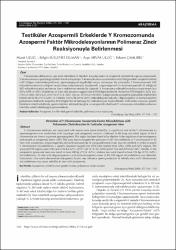| dc.contributor.author | Uluğ, Murat | |
| dc.contributor.author | Süsleyici Duman, Belgin | |
| dc.contributor.author | Arvas Uluğ, Ayşe | |
| dc.contributor.author | Çamlıbel, Teksen | |
| dc.date.accessioned | 2016-11-25T10:04:09Z | |
| dc.date.available | 2016-11-25T10:04:09Z | |
| dc.date.issued | 2006 | |
| dc.identifier.citation | Ulug M, Susleyici Duman B, Arvas Ulug A, Camlibel T. [Detection of Y chromosome azospermia factor microdeletions with polymerate chain reaction in testicular azospermic men]. Cerrahpaşa Tıp Derg 2006; 37(4): 126 – 130. | en_US |
| dc.identifier.issn | 1300-5227 | |
| dc.identifier.uri | http://www.ctf.edu.tr/dergi/online/2006v37/s4/a2.pdf | en_US |
| dc.identifier.uri | https://hdl.handle.net/11446/1178 | en_US |
| dc.description | İstanbul Bilim Üniversitesi, Tıp Fakültesi. | en_US |
| dc.description.abstract | Y kromozomu delesyonları, ağır erkek infertilitesi ile ilişkilidir. Karyotip analizi ve sitogenetik yöntemlerle yapılan çalışmalarda, Y kromozomunun spermatogenezdeki önemi anlaşılmıştır. Y kromozomunun uzun kolunun distal bölgesindeki azospermi faktörü (AZF) bölgesi mikrodelesyonlarının, spermatogenezi engellediği ortaya konmuştur. Bu çalışmada, Y kromozomunda AZF mikrodelesyonlarının varlığının araştırılması amaçlanmıştır. Azospermili, oligozoospermili ve normozoospermili 45 erkeğe ait AZF mikrodelesyonları polimeraz zincir reaksiyonu metodu ile saptandı. Y kromozomu mikrodelesyonlarını tespit etmek için AZFa AZFb ve AZFc bölgelerine ait 2’şer adet sequence tagged sites (STS) bölgesi kullanıldı. Kullanılan STS bölgeleri: AZFa için, sY84 ve sY86; AZFb için, sY127ve sY134; AZFc için ise, sY254 ve sY255’dir. Çalışmamızda azospermi grubundaki erkeklerden birinde 400 bç’lik sY254 (AZFc) ve 2 erkekte 126 bç’lik sY255 (AZFc) mikrodelesyonu bulundu. Oligozoospermi ve normozoospermi grubundaki erkeklerde araştırılan STS bölgelerine ait herhangi bir mikrodelesyon tespit edilmedi. Elde edilen sonuçlar, genetik faktörlerin infertil erkeklerde sperm üretimini etkileyebileceğini ve azospermili erkeklerde Y kromozomu mikrodelesyonlarının infertilite sebebi olabileceğini göstermektedir. | en_US |
| dc.description.abstract | Y chromosome deletions are associated with severe male factor infertility. A significant role of the Y chromosome in spermatogenesis was established with karyotype and cytogenetic analysis. Deletions in the long arm distal region of the Y chromosome are known to prevent spermatogenesis. This region has been found to be effective in the regulation of spermatogenesis and named as azospermia factor (AZF). This study has investigated the presence of AZF microdeletions of Y chromosome in 45 men with azospermia, oligozoospermia and normozoospermia by using polimerase chain reaction method. In order to search Y chromosome microdeletions, 2 spesific sequence tagged sites (STS) were studied from AZFa, AZFb and AZFc regions. The analyzed STS regions were sY84 and sY86 for AZFa, sY127 and sY134 for AZFb and sY254 and sY255 for AZFc. Results. In the azospermic group one man was found to have 400 bp sY254 (AZFc), whereas two were found to have 126 bp sY255 (AZFc) microdeletions. In men with oligozoospermia and normozoospermia none of the STS region microdeletions was detected. Conclusion. Our results demonstrate that genetic factors may influence sperm production in infertile men and Y chromosome microdeletions may cause infertility in men with azospermia. | en_US |
| dc.language.iso | tur | en_US |
| dc.publisher | İstanbul Üniversitesi, Cerrahpaşa Tıp Fakültesi | en_US |
| dc.rights | info:eu-repo/semantics/openAccess | en_US |
| dc.subject | azospermi | en_US |
| dc.subject | kısırlık-erkek genetik faktörler | en_US |
| dc.subject | polimeraz zincir reaksiyonu | en_US |
| dc.subject | azospermia | en_US |
| dc.subject | infertility-male genetic factors | en_US |
| dc.subject | polymerase chain reaction | en_US |
| dc.title | Testiküler azospermili erkeklerde Y kromozomunda azospermi faktör mikrodelesyonlarının polimeraz zincir reaksiyonuyla belirlenmesi | en_US |
| dc.title.alternative | Detection of Y chromosome azospermia factor microdeletions with polymerate chain reaction in testicular azospermic men | en_US |
| dc.type | article | en_US |
| dc.relation.journal | Cerrahpaşa Tıp Dergisi | en_US |
| dc.department | DBÜ, Tıp Fakültesi | en_US |
| dc.identifier.issue | 4 | |
| dc.identifier.volume | 37 | |
| dc.identifier.startpage | 126 | |
| dc.identifier.endpage | 130 | |
| dc.contributor.authorID | TR9812 | en_US |
| dc.relation.publicationcategory | Belirsiz | en_US |


















